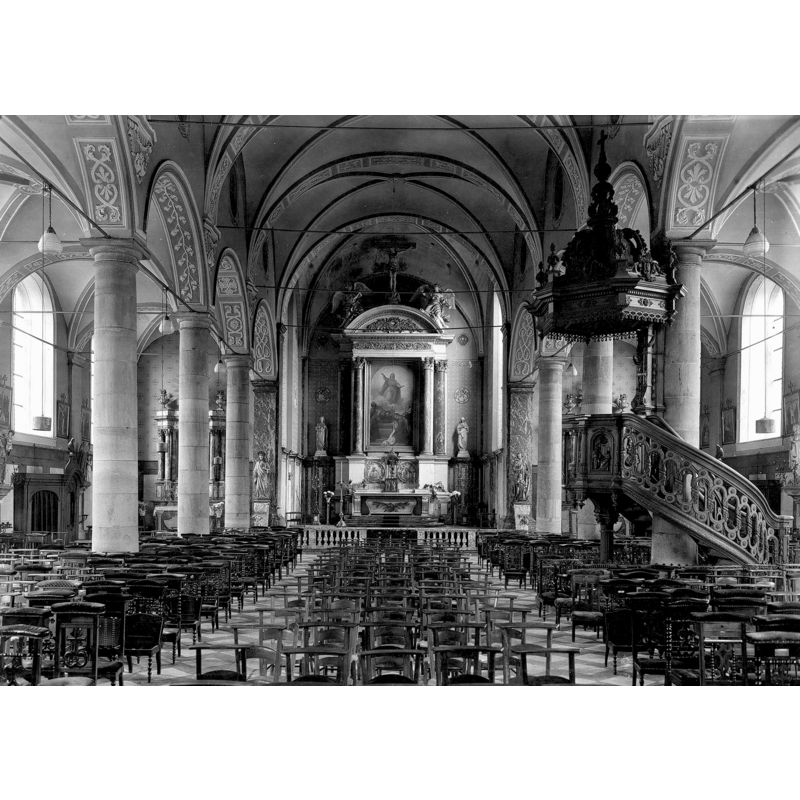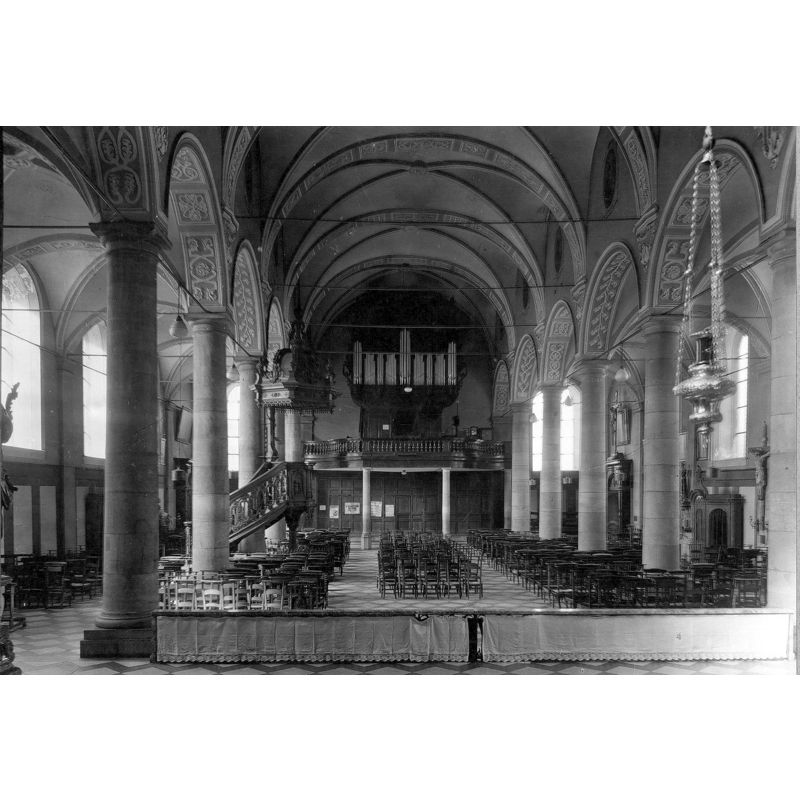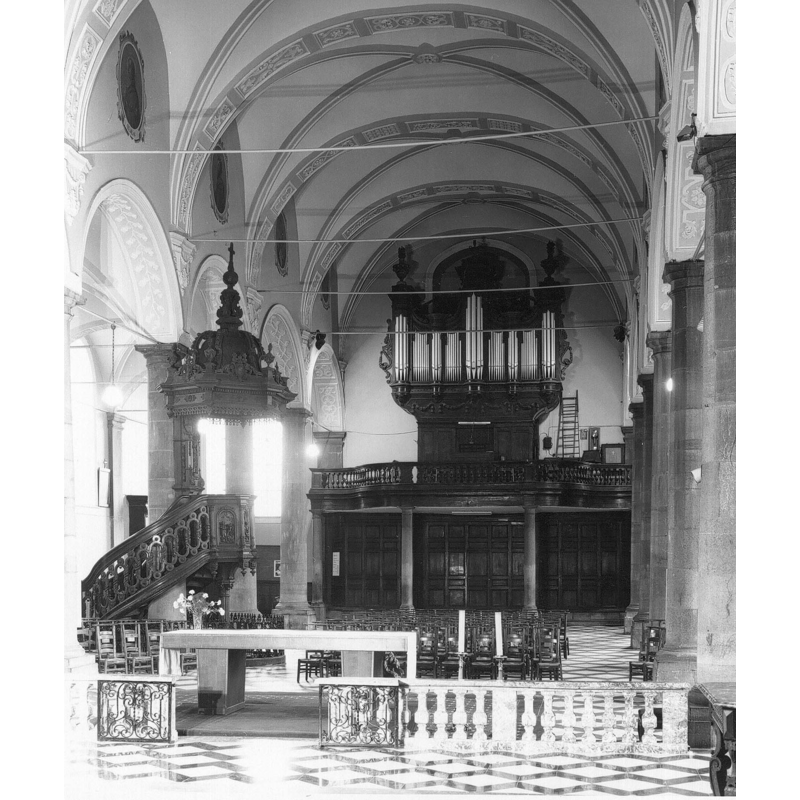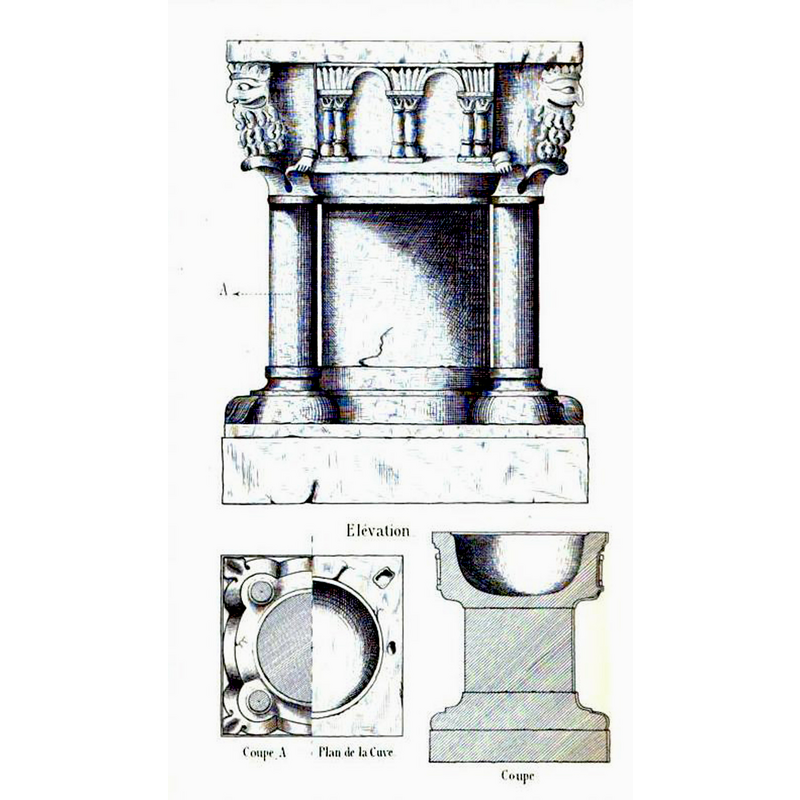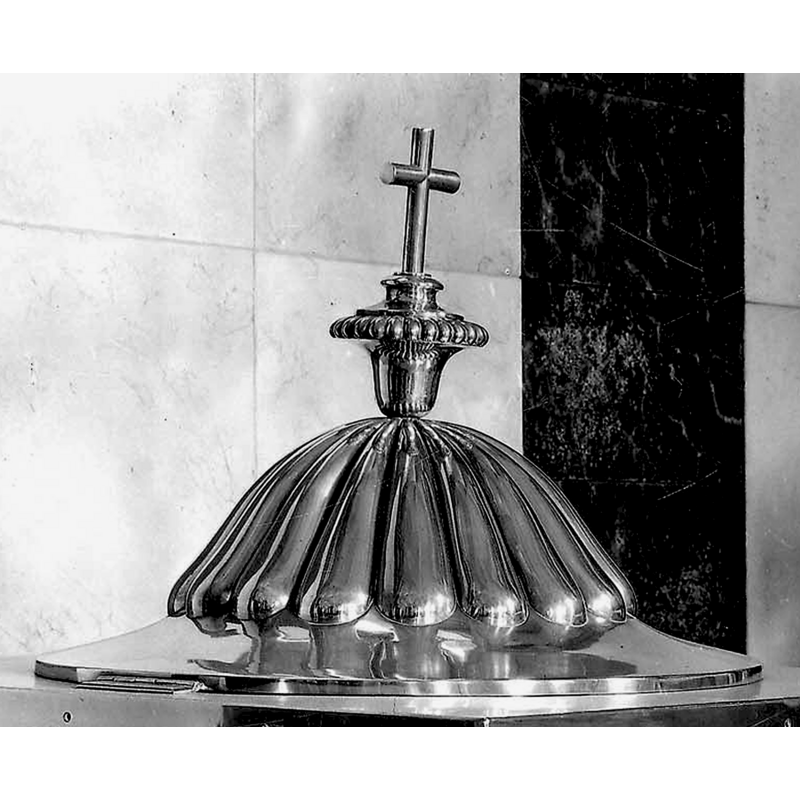Seraing / Seraing-aan-de-Maas / Seraing-sur-Meuse / Seraing sur Mouze / Seraingne / Serang / Serani / Serè
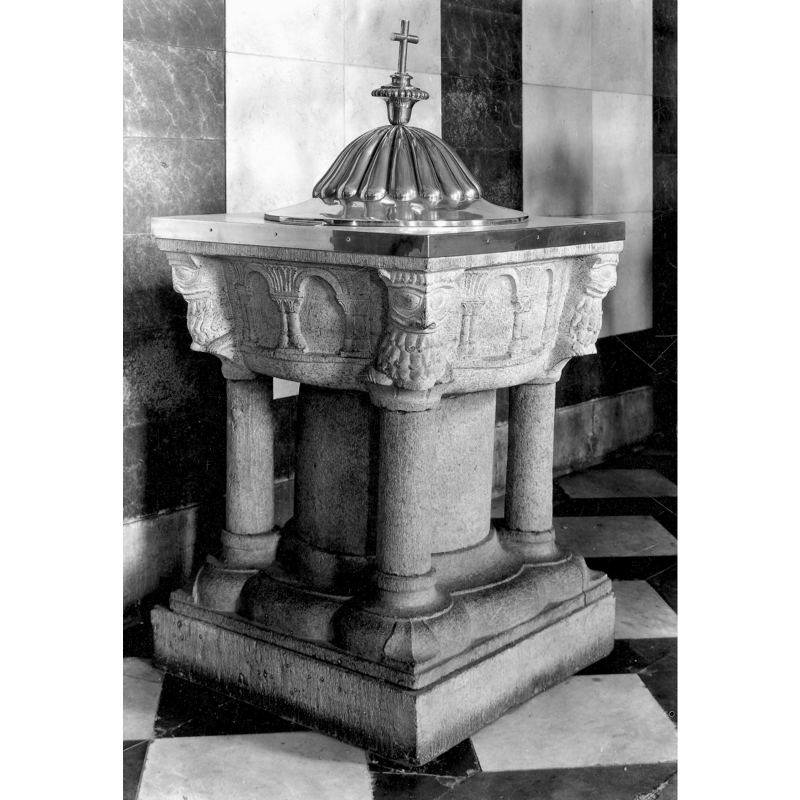
Image copyright © KIK-IRPA, Brussels (Belgium), 2015
Reproduced in accordance with KIK-IRPA guidelines
Results: 12 records
animal - bird - owl - 4
Scene Description: at 90-degree angles
Copyright Statement: Image copyright © KIK-IRPA, Brussels (Belgium), 2015
Image Source: detail of a B&W photograph taken in 1942 by the Commissariat général à la Restauration du Pays [KIK-IRPA, Brussels (Belgium), cliché B028270]
Copyright Instructions: Reproduced in accordance with KIK-IRPA guidelines
design element - architectural - arcade - blind - round arches - on double columns with capitals and bases - 8
Scene Description: two per side
Copyright Statement: Image copyright © KIK-IRPA, Brussels (Belgium), 2015
Image Source: detail of a B&W photograph taken in 1942 by the Commissariat général à la Restauration du Pays [KIK-IRPA, Brussels (Belgium), cliché B028270]
Copyright Instructions: Reproduced in accordance with KIK-IRPA guidelines
design element - motifs - foliage - palmette
Scene Description: in the spandrels of the arcade
Copyright Statement: Image copyright © KIK-IRPA, Brussels (Belgium), 2015
Image Source: detail of a B&W photograph taken in 1942 by the Commissariat général à la Restauration du Pays [KIK-IRPA, Brussels (Belgium), cliché B028270]
Copyright Instructions: Reproduced in accordance with KIK-IRPA guidelines
design element - motifs - leaf - lanceolated - 4
design element - motifs - moulding
view of church exterior
Scene Description: Source caption: "Vue gén. S.-O." [NB: if the the orientation is correct the 15thC tower is at the east end -- more likely that this is a northeast view of the church]
Copyright Statement: Image copyright © KIK-IRPA, Brussels (Belgium), 2015
Image Source: B&W photograph taken in 1942 by the Commissariat général à la Restauration du Pays [KIK-IRPA, Brussels (Belgium), cliché B028263]
Copyright Instructions: Reproduced in accordance with KIK-IRPA guidelines
view of church interior - nave - looking east
view of church interior - nave - looking west
Scene Description: pre-Vatican Council II
Copyright Statement: Image copyright © KIK-IRPA, Brussels (Belgium), 2015
Image Source: B&W photograph taken in 1942 by the Commissariat général à la Restauration du Pays [KIK-IRPA, Brussels (Belgium), cliché B028265]
Copyright Instructions: Reproduced in accordance with KIK-IRPA guidelines
view of church interior - nave - looking west
Scene Description: post-Vatican Council II
Copyright Statement: Image copyright © KIK-IRPA, Brussels (Belgium), 2015
Image Source: B&W photograph taken in 1973 by Charles Mahaux, I.R.P.A. [KIK-IRPA, Brussels (Belgium), cliché M208857]
Copyright Instructions: Reproduced in accordance with KIK-IRPA guidelines
view of font - elevation and section
view of font and cover
view of font cover
Copyright Statement: Image copyright © KIK-IRPA, Brussels (Belgium), 2015
Image Source: detail of a B&W photograph taken in 1942 by the Commissariat général à la Restauration du Pays [KIK-IRPA, Brussels (Belgium), cliché B028270]
Copyright Instructions: Reproduced in accordance with KIK-IRPA guidelines
INFORMATION
FontID: 09517SER
Object Type: Baptismal Font1
Church/Chapel: Eglise primaire / Eglise Notre-Dame de l'Assomption
Church Patron Saints: The Assumption of St. Mary
Church Location: Place Kuborn, 4100 Seraing, (Liège), Belgique
Country Name: Belgium
Location: Liège, Wallonie / Wallonne
Directions to Site: Located about half way between Liège and Huy
Ecclesiastic Region: Diocèse de Liège
Font Location in Church: Inside the church
Century and Period: 12th century, Romanesque
Workshop/Group/Artisan: Namur font? / Mosan type?
Cognate Fonts: Similar arcades on Mosan fonts at Ohey and Gingelom; similar corner lions at Ciney
Church Notes: original episcopal chapel founded here 1070s-1080s by Henri de Verdun [cf. FontNotes]
Font Notes:
Click to view
Described and illustrated in Van de Casteele (1877) with date in the late 11th or early 12th century: "Nous croyons pouvoir les attribuer au commencement du XIIe sinon à la fin du XIe siècle. En effet, ils appartiennent au style roman le plus pur et l'on retrouve dans leur ornementation tous les caractères qui distinguent le XIIe siècle"; Van de Casteele (ibid.) criticises the later handling of its restoration: "Malheureusement le ciseau moderne d'un ouvrier ignare en a, par un taillant mal habile, dénaturé l'aspect antique. De plus, il est à regretter qu'on ait placé sur cette cuve baptismale un couvercle en cuivre qui, par sa forme, offre un contraste bizarre avec le beau style roman de ce précieux monument. Une légende qu'on ferait mieux d'appeler une réclame et portant: 'A. Collin, à Liège, 1843', fait ressortir au vif ce singulier anachronisme". Even though he recognises that the style is 12th-century, Van de Casteele (ibid.) suggests the strong possibility that the font may have actually been the original of the 1070s-1080s "chapelle épiscopale érigée par Henri de Verdun, partant nous pouvons en conclure que les fonts baptismaux qui s'y trouvent encore aujourd hui proviennent de l'église première. On ne nous accusera donc pas de témérité si nous invoquons ces données historiques, pour démontrer que ces fonts remontent à la fin du XIe siècle et peut être vers les années 1075-82." Described and illustrated in Drake (2002): Mosan font consisting of a square [at the top, then round with animals] basin raised on a multisupport [broad central shaft and four angle colonnettes]; the arcade around the basin sides is decorated and rests on double columns. Drake (ibid) notes that these decorated double arches can also be found in the Mosan fonts at Gingelom and Ohey, that the number of arches at Seraing are only two per side, and that the lions at the corners are quite similar to those on the font at Ciney. This is a square mounted baptismal font of the Mosan type, with a cylindrical basin that has pronounced salient lions at the corners, which make it square; the sides of the basin are otherwise decorated with blind round arches; from each corner lion stems down a colonnette, all four of which form the base together with the broad central shaft; moulded lower base with a lower square volume or plinth. A copper sheath appears to cover a dark marble slab on the basin; it opens to a round hole for the inner basin; low-dome metal cover, modern and pudding-shaped, with Latin cross finial; crafted by A. Collin in 1843. The five columns of the base have moulded bases and rest on a lower base consisting of a thick round moulding with angle spur/leaf motifs and a square lower volume.
COORDINATES
UTM: 31U 676980 5606475
MEDIUM AND MEASUREMENTS
Material: stone, limestone (calcaire de Meuse?)
Number of Pieces: four
Font Shape: square (mounted)
Basin Interior Shape: round
Basin Exterior Shape: square
Diameter (inside rim): 60 cm*
Basin Depth: 28 cm*
Height of Central Column: 37 cm*
Font Height (less Plinth): 105 cm* / **
Trapezoidal Basin: 81 x 81 cm*
Notes on Measurements: * Van de Casteele (1877: 203) / ** KIK-IRPA, Brussels (Belgium)
LID INFORMATION
Date: 1843
Material: metal, brass
Apparatus: no
Notes: by A. Collin; 50 cm tall [cf. FontNotes]
REFERENCES
Drake, Colin Stuart, The Romanesque Fonts of Northern Europe and Scandinavia, Woodbridge, Suffolk: Boydell Press, 2002
Van de Casteele, D., "Fonts baptismaux à Huy, à Seraing et à Esneux", 13, Bulletin de l'Institut archéologique liégeois, 1877, pp. 195-214; p. 202-214
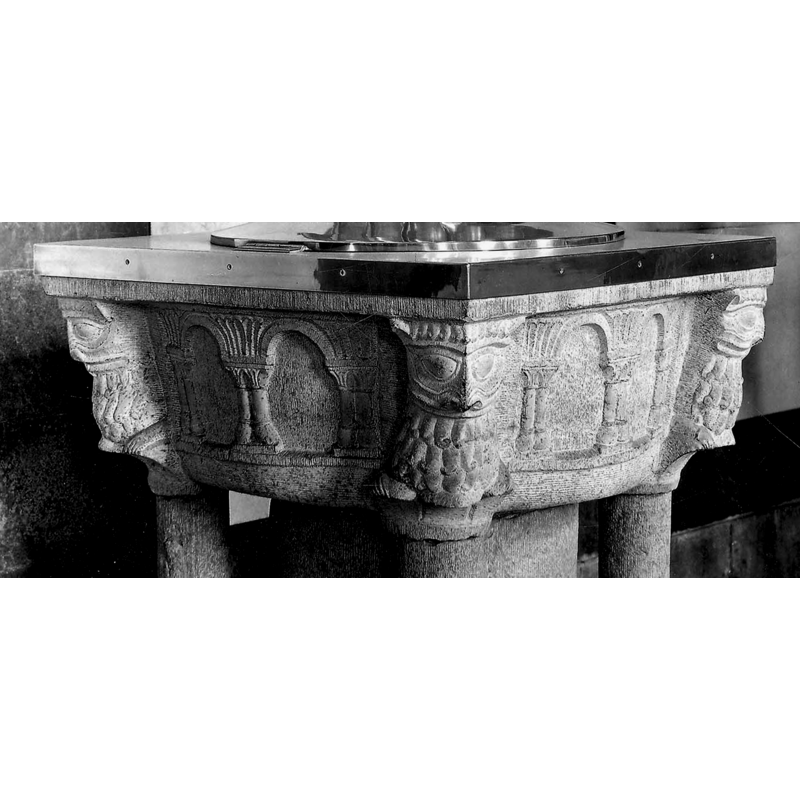
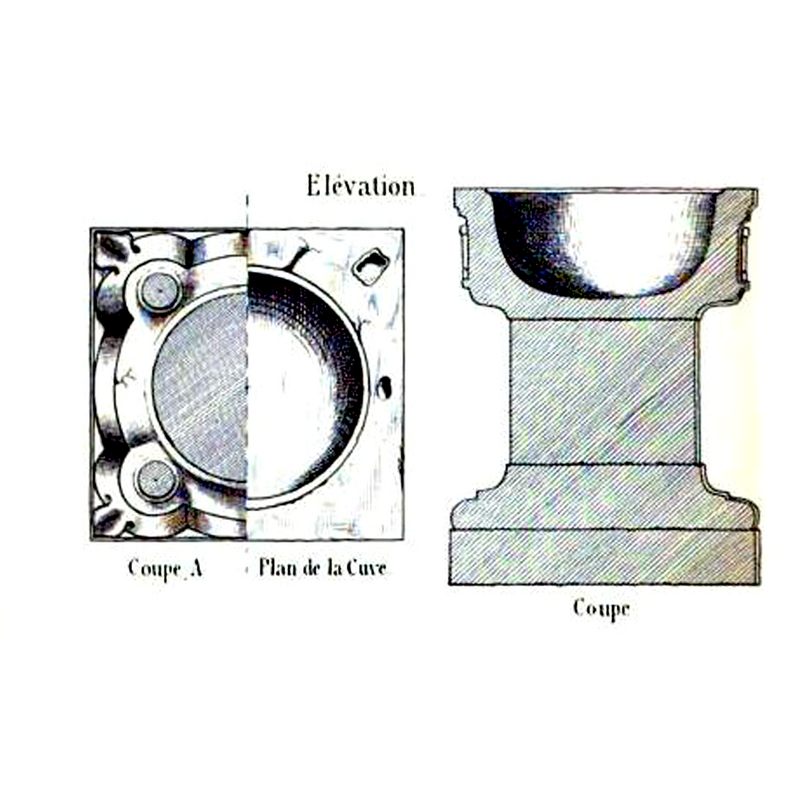
![Source caption: "Vue gén. S.-O." [NB: if the the orientation is correct the 15thC tower is at the east end -- more likely that this is a northeast view of the church]](/static-50478a99ec6f36a15d6234548c59f63da52304e5/compressed/1150330013_compressed.png)
